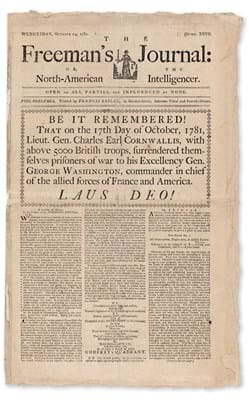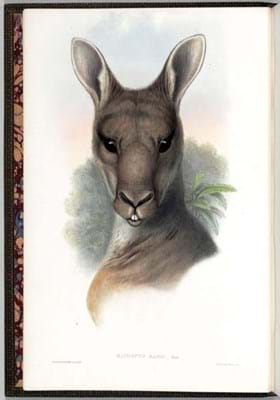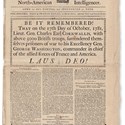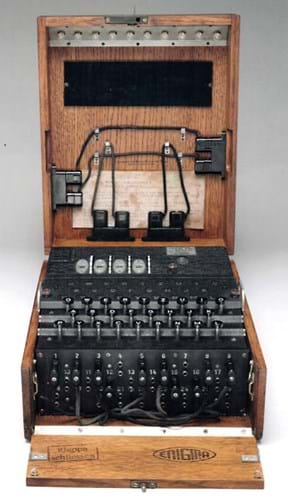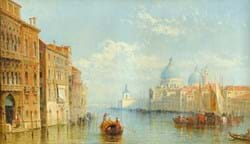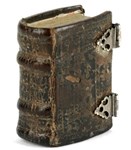Some have already brought exceptional results – just a few of which are briefly noted in this column – but in coming weeks ATG will be reporting on many more highlights from this rich vein of UK, US, French and other auctions.
Sale trio on single day
Three auctions were held on just one day, June 15, by Christie’s New York (25/20/12% buyer’s premium) and between them these sales raised a premium-inclusive $9.71m (£7.74m) – the overture being provided by the Metropolitan Opera Guild collection.
This 90-lot sale comprised musical scores and other treasures gifted to the guild since its foundation in 1935 and now being sold to help secure the future of the Metropolitan.
An autograph album assembled in the years 1892-1906 in Paris, containing musical quotations and photographs of celebrated composers, was the subject of an online preview.
It sold at $30,000 (£23,625), but the star turns were a Mozart letter and a Schubert piano sonata.
Sent in March 1784 from Vienna, where he was by then well established, Mozart’s letter to his father, Leopold, and his sister, Nannerl, describes on a single page his busy career and “…a whirl of composing, teaching and performing”. It sold for $260,000 (£204,725).
Bid to a low-estimate $340,000 (£267,715) was Schubert’s Piano Sonata in A flat major (D557), an early piece for piano in the classical style. The eight-page manuscript is dated May 1817.
From music, the day’s business moved on to the feathered world and the select, 38-lot ornithological library of Dr Gerald Dorros.
Top lot was one of the Goulds, a finely bound, eight volume set of The Birds of Australia of 1840-48. Presenting 681 coloured litho plates in all, it brought a bid of $190,000 (£149,605), but Christie’s had hoped for as much as $350,000.
In the headier days of the high-end natural history colour plate market Gould’s own copy made £170,000 at Sotheby’s in 1988 and two years later Christie’s sold another set for that same sum.
The Gould illustration on the facing page features not a bird, but a marsupial. The quizzical stare of the ‘Macropus Major’, or kangaroo is found on one of the 183 coloured litho plates that make up a set of Gould’s three-volume Mammals of Australia (1845-63). In this instance the selling price almost doubled the previous best at $130,000 (£102,360).
The third and biggest of these New York sales opened with a further selection from the ‘How History Unfolds on Paper’ collection formed over several decades by Eric Caren.
This was the fifth such sale of eyewitness letters, newspapers, broadsides and other material marking historical or otherwise significant events.
In Caren’s own words, this was the crème de la crème, “…as good as it gets, either due to content, display value, rarity, provenance or a combination of these factors”.
Two further sales will be held later this year by Cowans of Cincinnati, but this really was the main event.
American material has understandably been dominant in these sales and a Christie’s NY highlight was a copy of the Daily Federal Republican for September 22, 1814, which in one column on the second of its four densely typeset pages presents the first obtainable printing of Francis Scott Key’s poem ‘The Star Spangled Banner’.
What in time became the American national anthem was inspired by Key’s experience of witnessing the British naval bombardment of Fort McHenry in Baltimore harbour during the War of 1812. This sold for $135,000 (£106,300).
Bid to $110,000 (£86,614) was another four-page newspaper, the October 24, 1781 issue of the Philadelphia Freeman’s Journal…
Here, unprecedented banner headlines proclaim the news of Cornwallis’ surrender at Yorktown.
Not everything was American. Bid to $28,000 (£22,050) was a simple handbill – one of as many as 80,000 that were issued by the Metropolitan Police Office in September 1888 for distribution to every household in the Whitechapel district of London.
It sought help in finding whoever was responsible for the murder of three local women – two of them, Elizabeth Stride and Catherine Eddowes, killed within an hour of each other on the very day that it was printed. The man (or woman?) they sought we still know only as Jack the Ripper.

Andrew Russell’s The Great West Illustrated in a series of Photographic Views… was sold at $260,000 (£204,725) by Christie’s New York.
The Caren archive was followed by a general sale that included such diverse lots as a finely bound presentation copy of the 1799 first edition of Goya’s Los Caprichos aquatints, at $450,000 (£354,330), and Andrew Russell’s The Great West Illustrated in a series of Photographic Views across the Continent…, at $260,000 (£204,725). Both were record prices.
The latter was published in 1869 for the Union Pacific Railroad and in its 50 albumen prints records the construction of the section of the line between Omaha, Nebraska and Promontary Point, Utah. As such it offers an unusual and valuable record of the opening up of the West.
Machines as well as books, letters, manuscripts and photographs were also part of this sale.
One was a working example of the Apple-1 personal computer launched by Steve Jobs and Steve Wozniak in Palo Alto, California in 1976. Then it was priced at $666.66 and this one made $290,000 (£228,345), but the saleroom had hoped for more. In 2014 Bonhams New York sold another example for $750,000 to the Henry Ford Museum.
Enigma Machines used by the German armed forces during the Second World War are no stranger to the salerooms. However, none, I think, has ever sold for more than the £450,000 (£354,330) given for the rare M4 example offered in New York.
An advanced, four-rotor machine ordered by Admiral Dönitz for use by the U-boat fleet, it was the hardest Enigma to decrypt. The work to crack its secrets, carried out under the directions of Alan Turing and Joe Desch, led eventually to the development of the world’s first programmable computer.


